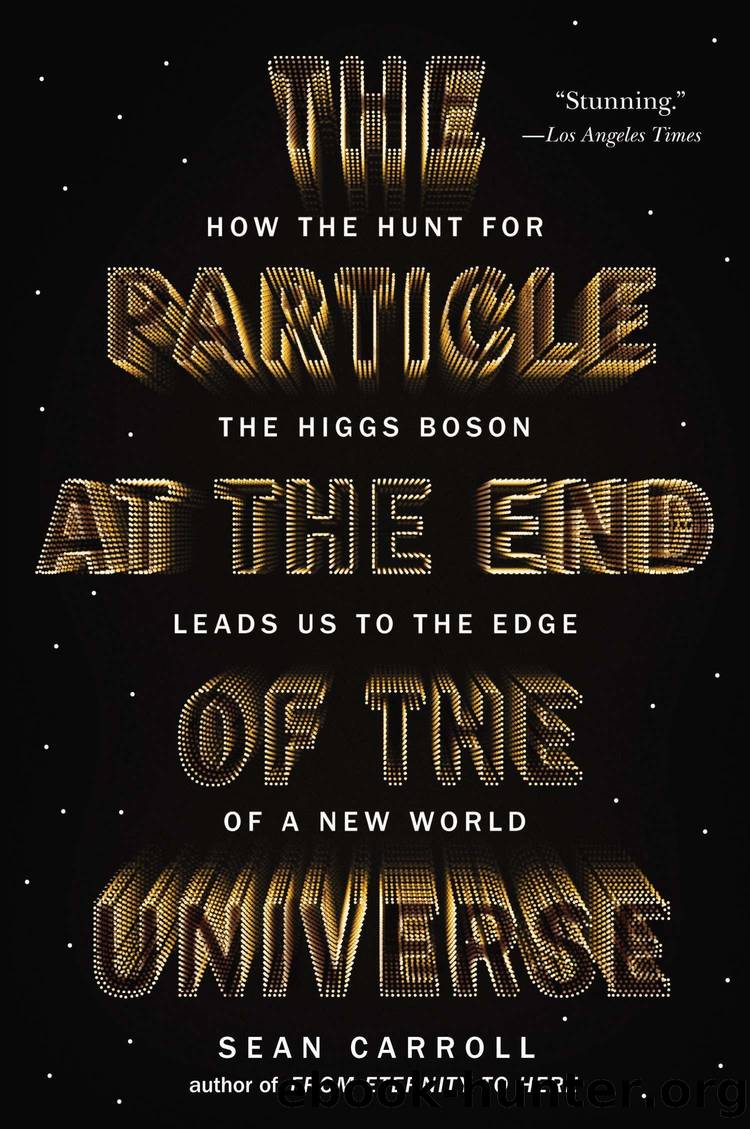The Particle at the End of the Universe by Sean Carroll

Author:Sean Carroll [Carroll, Sean]
Language: eng
Format: epub
Publisher: Penguin Publishing Group
Published: 2012-11-13T00:00:00+00:00
Signal and background
Particle physics, since it is powered by quantum mechanics, is a lot like coin flipping: The best we can do is predict probabilities. At the LHC, we smash protons together and predict the probability of different interactions occurring. For the particular case of the Higgs search, we consider different âchannels,â each of which is specified by the particles that are captured by the detector: Thereâs the two-photon channel, the two-lepton channel, the four-lepton channel, the two-jets-plus-two-leptons channel, and so on. In each case, we add up the total energy of the outgoing particles, and the machinery of quantum field theory (aided by actual measurements) allows us to predict how many events we expect to see at every energy, typically forming a smooth curve.
Thatâs the null hypothesisâwhat we expect without any Higgs boson. If there is a Higgs at some specific mass, its main effect is to give a boost to the number of events we expect at the corresponding energy: A 125 GeV mass Higgs creates some extra particles with a total energy of 125 GeV, and so on. Creating a Higgs and letting it decay provides a mechanism (in addition to all the non-Higgs processes) to produce particles that typically have the same total energy as the Higgs mass, leading to a few additional events over the background. So we go âbump huntingââis there a noticeable deviation from the smooth curve we would see if the Higgs wasnât there?
Predicting what the expected background is supposed to be is by no means an easy task. We know the Standard Model, of course, but just because we know what the theory is doesnât mean itâs easy to make a prediction. (The Standard Model also describes the earthâs atmosphere, but itâs not easy to predict the weather.) Powerful computer programs do their best to simulate the most likely outcomes of the proton collisions, and those results are run through a simulation of the detectors themselves. Even so, we readily admit that some rates are easier to measure than to predict. So it is often best to do a âblindâ analysisâuse some method to disguise the actual data of interest, by adding fake data to it or simply not looking at certain events, then making every effort to understand the boring data in other regions, and only once the best possible understanding is achieved do we âopen the boxâ and look at the data where our particle might be lurking. A procedure like this helps to ensure that we donât see things just because we want to see them; we only see them when theyâre really there.
It wasnât always so. In his book Nobel Dreams, journalist Gary Taubes tells the story of Carlo Rubbiaâs work in the early 1980s that discovered the W and Z bosons and won him a Nobel Prize, as well as his less successful attempts to win a second Nobel by finding physics beyond the Standard Model. One of the tools that Rubbiaâs team used in their
Download
This site does not store any files on its server. We only index and link to content provided by other sites. Please contact the content providers to delete copyright contents if any and email us, we'll remove relevant links or contents immediately.
The Complete Stick Figure Physics Tutorials by Allen Sarah(7264)
Secrets of Antigravity Propulsion: Tesla, UFOs, and Classified Aerospace Technology by Ph.D. Paul A. Laviolette(5237)
Thing Explainer by Randall Munroe(3849)
The River of Consciousness by Oliver Sacks(3498)
The Order of Time by Carlo Rovelli(3096)
How To by Randall Munroe(2969)
A Brief History of Time by Stephen Hawking(2911)
I Live in the Future & Here's How It Works by Nick Bilton(2900)
The Great Unknown by Marcus du Sautoy(2612)
What If?: Serious Scientific Answers to Absurd Hypothetical Questions by Randall Munroe(2587)
Midnight in Chernobyl by Adam Higginbotham(2432)
Blockchain: Ultimate Step By Step Guide To Understanding Blockchain Technology, Bitcoin Creation, and the future of Money (Novice to Expert) by Keizer Söze(2409)
Networks: An Introduction by Newman Mark(2303)
The Meaning of it All by Richard Feynman(2268)
Easy Electronics by Charles Platt(2251)
The Tao of Physics by Fritjof Capra(2204)
Midnight in Chernobyl: The Untold Story of the World's Greatest Nuclear Disaster by Adam Higginbotham(2126)
When by Daniel H Pink(2057)
Introducing Relativity by Bruce Bassett(2048)
